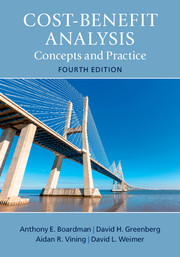Chapter 19 - Distributionally Weighted Cost-Benefit Analysis
from PART IV - RELATED METHODS
Summary
Government policies, programs, and projects typically affect individuals differently. Thus, in conducting CBAs, analysts often report benefits and costs for separate categories of people. The relevant classification of individuals into groups for this purpose depends on the specific policy under evaluation. Some examples include consumers versus producers versus taxpayers, program participants versus nonparticipants, citizens (of a nation or a state or a city) versus noncitizens, and high-income groups versus low-income groups. This chapter focuses on the most common form of distributionally weighted CBA, which that involves high-income versus low-income groups.
Once individuals are divided into categories, the first issue that must be decided is whether each group will be given standing in the CBA.1 For example, in conducting a CBA of U. S. regulatory policy on acid rain, a decision must be made as to whether to give standing to Canadians affected by acid rain resulting from manufacturing in the United States. Similarly, when evaluating a policy that impacts foreignbased and owned companies, one must decide whether to give standing to foreign shareholders.
Given a decision on standing, costs and benefits may be reported separately for each group with standing. This idea was introduced in Chapter 3 and expanded on in Chapter 4 in the context of a social accounting ledger. The usefulness of showing the impacts on each group separately is illustrated by the following hypothetical example. Here, it is assumed that the government is considering proposals from three different (national) companies for constructing and operating a pipeline that would transport oil from inside the country to customers in another country. Consider, for example, a pipeline from Northern Canada into the United States. The benefits and costs associated with each proposal may be presented in two ways.
Table 19-1 exemplifies “traditional” CBA, which ignores distributional considerations. Impacts are categorized as benefits or costs from the perspective of society as a whole. Society would be better off if it adopted Company A or B's proposals than no pipeline (the NPV of the net social benefits are positive) and would be best off by adopting Company B's proposal. In contrast, Table 19-2 indicates how three different groups would be affected by each proposal. It shows that all firms would enjoy net benefits as their profits (producer surplus) would be positive.
- Type
- Chapter
- Information
- Cost-Benefit Analysis , pp. 489 - 506Publisher: Cambridge University PressPrint publication year: 2017



